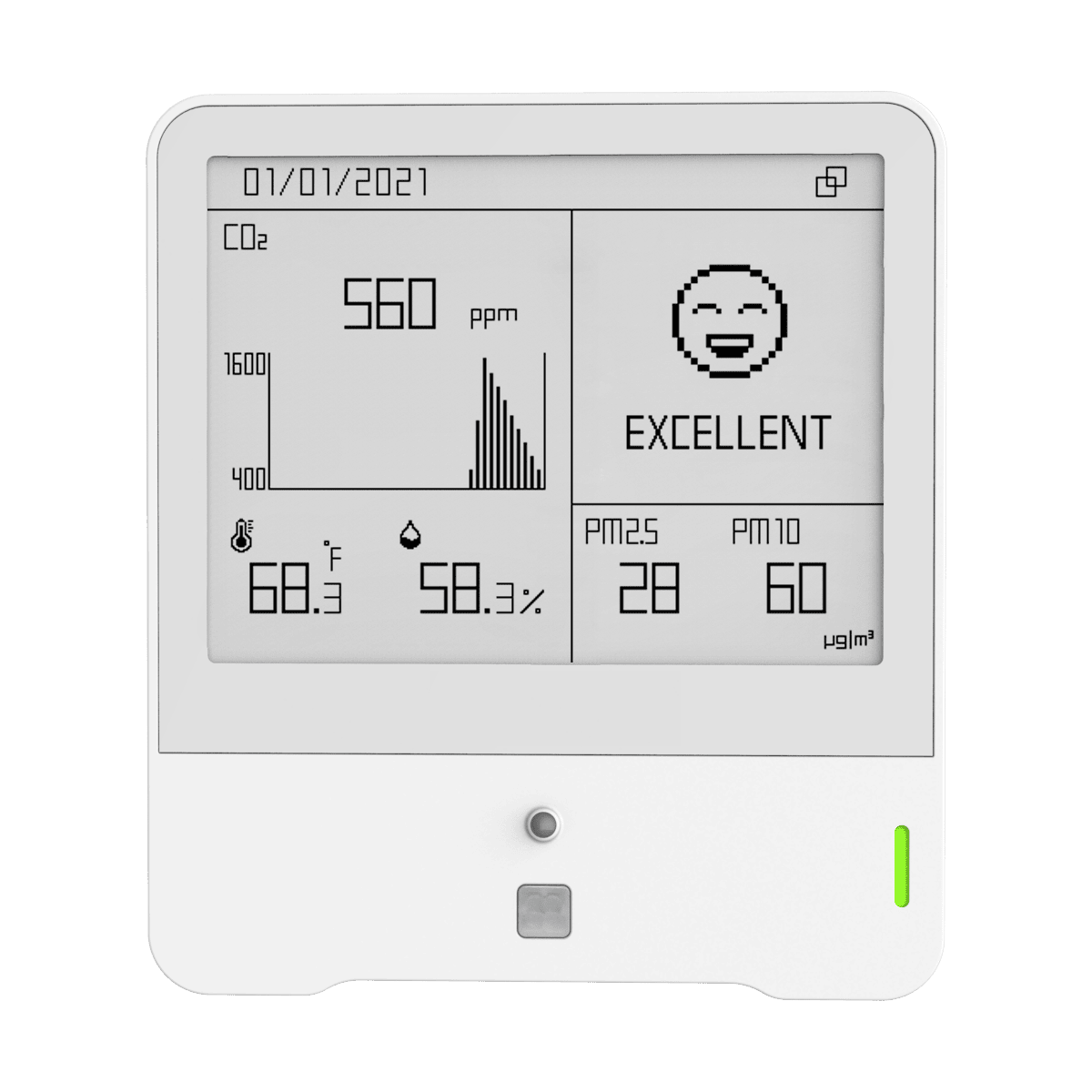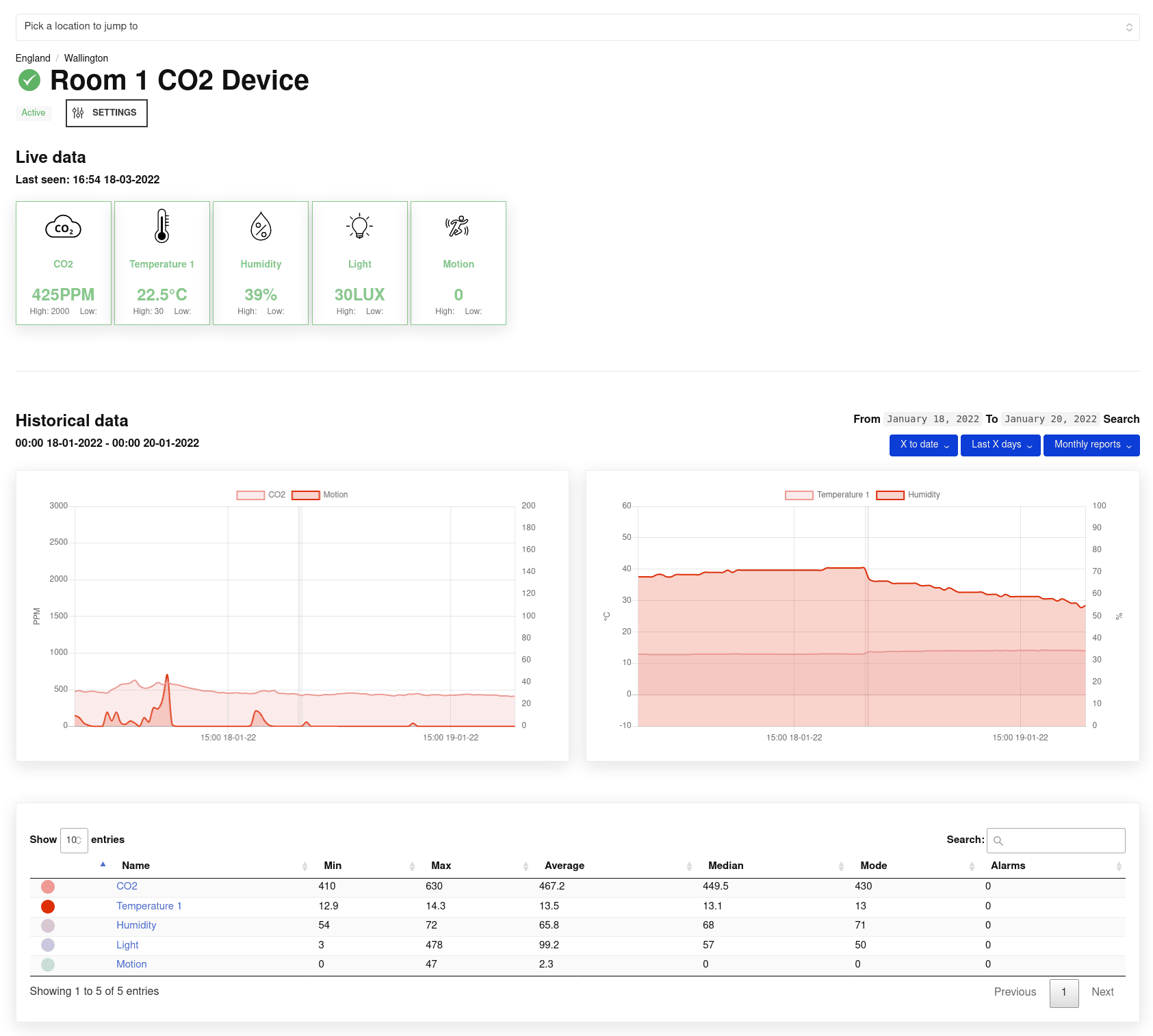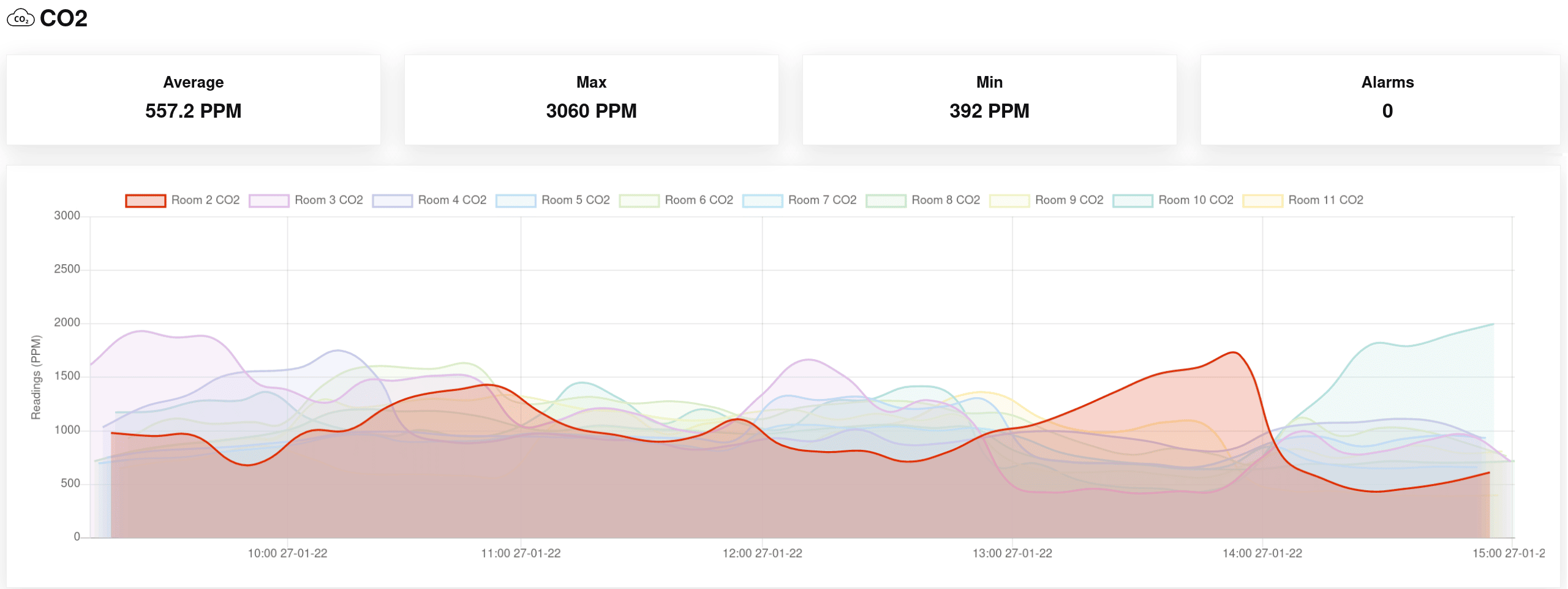Intelligent air quality and CO2 monitoring
Remote indoor monitoring to limit the spread of aerosol related viruses and increase staff productivity.

STOP! Understand the benefits of intelligent versus stand alone sensors before buying.
Improve productivity by monitoring air quality
Monitoring CO2 levels in enclosed spaces has become more important since the Covid-19 pandemic, but there are a host of additional benefits in monitoring work area spaces; from increasing employee productivity to limiting the spread of common viruses that may cause staff absences.

Monitoring specialists
CO2 and air quality monitoring made easy
Monitoring CO2 and air quality using hand held meters is a time consuming activity that requires labour, time and resource to complete.
OmniWatch automates this process and makes monitoring easy.
Spook and OmniWatch was voted Specialist Technology Company of the Year and Most Innovative Solution of the Year at the annual UK CIR Business Continuity Awards.
Automated monitoring
Reduce labour costs and resources
Automatic sensor reading collection means users don't waste valuable time in manually collecting data from a sensors on-board data logger.
Sensors can be left in situ to measure air quality as occupancy levels fluctuate.
Enterprise centric
Cloud based monitoring
Designed to be the central repository for all things monitored, OmniWatch digital dashboards come pre-configured in handy online portals for hassle free monitoring and alerting.
Being cloud based means user access is secure and available via any internet enabled device.
Granular management
Automated sensor updates and user access
Updating software and settings to multiple sensors is performed centrally saving time, effort and resources for sensor management.
Sensor data is automatically filtered in accordance with a users organisational hierarchy, this ensures alarms and user access to sensor data is confined to authorised staff.
Examples of hierarchical access are: Global managers, regional workers, building team members and local facility staff.
Scaleable solution
Monitoring for small to large installations
OmniWatch is designed to be completely scaleable; ranging from an entry level system monitoring a handful of sensors to an enterprise-wide solution covering many locations across multiple time zones.
Monitoring footprints typically evolve and can increase or reduce overtime.
Spook has a proven track record in modifying the level of monitoring in-line with an organisations requirement for change.
The most common air quality sensors
CO2 ppm
Temperature
Humidity
Light
Motion/PIR
Total volatile organic compounds (TVOC)
Barometric pressure
Formaldehyde (HCHO)
PM2.5 & PM10
Ozone (O3)
Digital dashboards

OmniWatch digital dashboards are bespoke and designed by Spook on behalf of our users.
All the hard work of setting up sensors, adding equipment and configuring how the alarm work-flow and sensor management is implemented is included as part of the overall OmniWatch solution.


Emoji overviews

A picture paints a thousand words and the art of remote monitoring is to make identifying alarms quick and easy.
Using emoji for a high level overview is ideal for managing air quality devices that have multiple sensors.
Spook emoji are able to be expanded to focus on the individual monitored conditions of different equipment types and multi-function sensors.
Trend analysis

Unlike traditional data loggers that track readings for a limited amount of time, OmniWatch stores sensor readings in perpetuity to allow for greater trend analysis accuracy.

A few examples of air quality monitoring:
CO2
CO2 levels in indoor working spaces has a direct correlation to the well being of the people occupying the area.
Generally speaking low CO2 levels increase productivity and reduce sickness of staff and visitors.
Activity
Activity within an area directly effects the levels of indoor CO2.
The more people within an area or where occupancy is used for more active events rapidly ramps up CO2 levels to potentially unhealthy levels.
Light
Light can have a huge impact on a worker's health and their productivity.
People deprived of natural light are found to be more tired, more prone to insomnia, more distractible and less active.
Ambience
Sick Building Syndrome is caused by a mixture of things such as dry air, ventilation, temperature, humidity, air renewal rates, noise levels and lighting.
This can cause occupants to feel unwell, leading to absenteeism and poor mental health.
Spook recommended sensors
LoRaWAN NDIR (Non-dispersive infrared) multi-function sensors
Spook works with any networked based air quality sensor so for organisations that have already invested in sensor hardware they are usually 100% compatible with OmniWatch.
If you are new to monitoring and need to source sensors Spook recommends using LoRaWAN devices as they are the most widely used technology for the Internet of Things (IoT). Our most popular sensors are detailed below as Type A and Type B:
Out of the box
Preconfigured
Calibrated
Batteries included
Out of the box
Preconfigured
Calibrated
Batteries included
Type A Sensor
Monitored conditions: CO2, temperature, humidity, light level and motion detection
- Nondispersive infrared sensor (NDIR)
- No onboard display panel
- LED traffic light function
- Wall mounted
- Powered by 3.6V AA Lithium batteries (x2)
Type B Sensor
Monitored condition: as per Type A plus TVOC & barometric pressure
- Nondispersive infrared sensor (NDIR)
- E-ink display screen to show the sensor values on the actual unit itself
- LED traffic light function
- Buzzer alarm function
- Wall mounted
- Powered by AA standard batteries (x2)

Wireless cellular and ethernet gateways
Spook recommended gateways come with ethernet and cellular connectivity as standard.
Gateways reside in appropriate locations around the building - dictated by the spread of sensors.
Sensor data is transmitted over the ethernet network with a cellular backhaul and is encrypted end to end and is sent to Spook's OmniWatch servers.
Gateways can be set to cellular operation as priority, ensuring monitoring is independent of the corporate network.
SIM features
Cellular gateways each have a pre-installed data roaming SIM card.

Data roaming
Each SIM is configured to work on all major cellular networks.
Full LTE support
SIMs are capable of utilising 4G, 3G and 2G to ensure there is always a strong signal.
Price included
SIM data charges are already included in Spook's pricing model. No hidden surprises.
OmniWatch key features
Cloud based
OmniWatch is cloud based and is accessed via any internet enabled device.
Digital dashboards
OmniWatch dashboards provide interactive and intuitive access to sensor readings 24/7.
Scaleable installations
Totally scaleable from a handful of sensors to a global solution monitoring 1000s of devices.
Trend analysis
Sensor readings are held in perpetuity; providing accurate historical trend analysis.
Automated reporting
Comprehensive reports can be scheduled to be auto emailed daily, weekly and monthly.
Spook 3-tier alarm escalation process
Alerts are sent in real-time and have three stages. At each stage there is a time delay to allow you to acknowledge the alarm.
If alarms aren't acknowledged they pass to the next stage, eventually culminating to Spook's UK call centre where an agent is tasked with calling you and your team.
Should an alarm be acknowledged before passing to the next stage, the alarm escalation period is ceased and you and your team are emailed to confirm matters.

Stage 1
Email alerts
Email alerts are the first level of communication within OmniWatch.
Emails are broadcast the moment an alert condition is discovered and logged.
Emails contain all the information you need to know regarding what has caused the alarm and includes any linked documents such as floor-plans and trend data.
Stage 2
SMS alerts
SMS messages are sent 15 minutes later if no-one has acknowledged the Stage 1 email.
The text contains a brief overview of the issue.
Users can confirm receipt of the alarm by replying to the SMS, this ceases the alarm escalation procedure and lets other team members know you are aware of the issue.
Stage 3
UK call centre
Spook's UK call centre manages alerts 15 minutes after the Stage 2 SMS message if no-one has replied to the original text. The agents are tasked with calling customer personnel in-line with the pre-agreed emergency rota.
All call information, for example who was called and at what time they were contacted, are logged within OmniWatch for future reference and audio recordings are available upon request.

The HSE (Health & Safety Executive) states that organisations need to ensure that indoor areas that have a high influx of people such as; offices, education establishments and other internal areas, must make sure there's an adequate supply of fresh air (ventilation).
This can be achieved by natural or mechanical ventilation. This advice has not changed during the Covid-19 pandemic.
More information relating to HSE ventilation guidance is available here.
Natural ventilation

Mechanical ventilation

Swift identification of poorly ventilated areas
There are many ways to identify poorly ventilated areas however there are three main protagonists. We recommend focusing on any areas that are more likely to have ventilation issues before extending monitoring to other areas.
No natural or mechanical ventilation
If an area where people work or spend extended periods of time have neither natural or mechanical ventilation then there is a risk of contaminated air not being removed and an increase chance of exposing them to airborne pathogens.
No outdoor air supply
If a rooms air is supplied by a mechanical ventilation system that either has no outdoor air supply or is set to incorrectly recirculate a large percentage of air, the risk of exposure is similar to a room that doesn't have any ventilation.
Stuffy or bad smell
A room that feels stuffy or has a lingering bad smell is a good indication that it lacks adequate ventilation due to the lack of fresh air.


Increased productivity
A recent study showed that employees in an environment with all TVOCs removed performed 61% better on cognitive tasks than in the standard office conditions.
Furthermore, by introducing improved ventilation as well their cognitive performance increased by more than 100%.


Keep up with government and regulatory guide lines
Councils and the HSE have powers to shut down work areas for not being Covid safe.
As guidance evolves applying changes to air quality sensors is important.
How to install a CO2 sensor

Sensors should be mounted within the breathing zone which is 4-6ft above the floor on an internal wall.
For industrial CO2 sensors should be mounted in the floor zone which is 6 inches above the floor.
If possible position the sensor near the centre of the room being monitored using a pillar or other permanent structure.

Sensors should be positioned away from sources of ventilation (natural and mechanical) as well as heating equipment to stop false values being recorded.

Sensors should not be located within 50cm of where people sit or work as this can also cause artificially inflated readings to be produced.
New to monitoring
We help organisations start monitoring projects from scratch. We have a wealth of experience that is free and helpful in creating an informed approach to monitoring.
We are also resellers to industry leading sensor and equipment manufacturers and can recommend the most appropriate hardware and sensors to fit any size monitoring project.
We had been considering monitoring for a while but did not have the resource or the knowledge to fully understand how to go about doing things from scratch.
We approached Spook as they have lots of experience in looking independently at monitoring projects. They recommended and provided the most appropriate hardware and sensors for us.
The sensors arrived pre-configured and were implemented on OmniWatch by Spook before we installed them.

Additional monitoring
Many of our customers have tried monitoring for themselves.
This ranges from institutions that rely on equipment onboard data loggers and communications cards; to organisations that have started monitoring projects but need help to extend monitoring to new areas and/or implement a central monitoring solution.
We needed a remote monitoring service that did not require an on premise PC and was independent of our network.
Spook provided pre-configured cellular routers for each of our five locations across the UK. The whole project was a simple plug-and-play solution with no involvement from us.

We had been considering monitoring for a while but did not have the resource or the knowledge to fully understand how to go about doing things.
When we Googled the various areas of interest we got more confused.
We approached Spook as they have a different outlook to simply buying hardware and sensors. Thankfully we now have a fully installed, joined up monitoring solution.

We had a series of climate monitors installed in our server rooms. Due to a change in our security policy we needed a remote monitoring service that did not require an on premise PC and was independent of our network.
Spook suggested a technology upgrade and provided pre-configured cellular routers for each of our five server locations across the UK. The whole project was a simple plug-and-play solution with no involvement from us.

Resources
Gov.uk
Coronavirus - how to stay safe and help prevent the spread
University College London
Study on increased productivity
Health and Safety Executive
Ventilation during coronavirus (Covid-19) pandemic
Harvard University
Study controlled exposure study of green and conventional office environments
BioMed Central
Recognition of aerosol transmission of infectious agents
Harvard Business Review
The average office versus the office with cleaner air
Department for Education
Schools Covid-19 operational guidance
Health and Safety Executive
How CO2 monitors help identify poor ventilation
Imperial College London
CO2 monitoring recommended to manage COVID-19 spread in schools and offices
Health and Safety Executive
Sick Building Syndrome
American Society of Heating, Refrigerating and Air-Conditioning Engineers